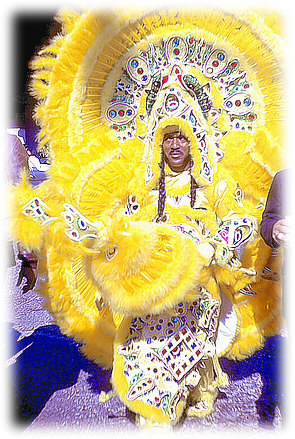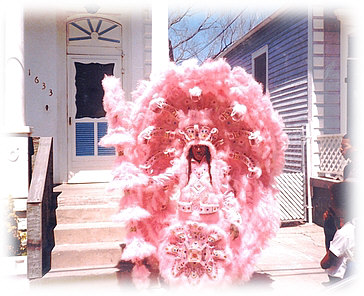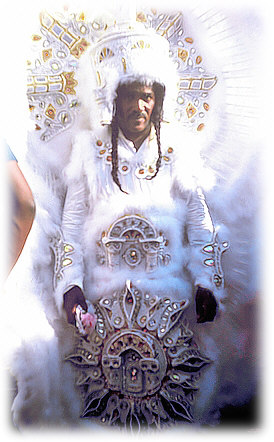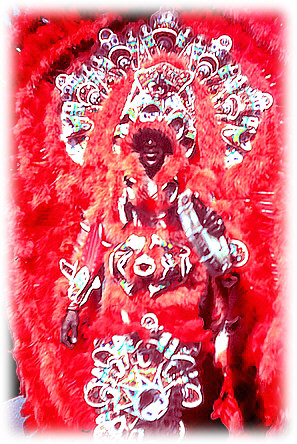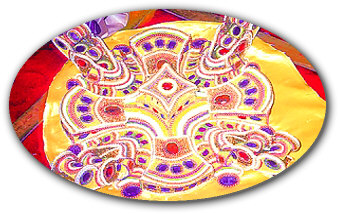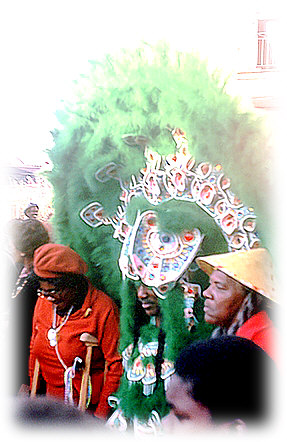
|
My Knee Will Bend No More
Tootie Montana at Hunter's Field on Super Sunday 2004, the last time he masked Indian. Whenever I met Tootie, wherever I met him, no matter the setting, no matter who was watching, I would bow down on one knee before him. Literally. He would chuckle his soft acknowledgement of my respect for him.
I am a big man, some even find my presence intimidating, so I know it was a strange sight to see: 200-plus pounds of Blackness bowing down to a burnished brass-colored, soft-spoken, neat but not flashily dressed, African-American male. But, there it is. Or was. Kalamu on the ground at Tootie's feet.
Tootie Montana was a culture bearer worthy of the highest respect. What he did was never done before, and will probably not be done again. It was not just more than 50 years of masking. It was not just setting a record for consecutive years of masking. It was not just constantly being the prettiest. Although all of that is true.
I bowed down to Tootie because he used our culture to stop the violence.
Mardi Gras Indian culture was no walk in the park. Hatchets and guns used to be more than mere props and decorative accoutrements. When they sang "Meet The Boys On The Battlefront," they were not just nostalgically whistling Dixie, as do so many who claim fidelity to a bygone era but who are warriors only in their imaginations.
Tootie looked at his world as it was and decided to make it better and more beautiful. He was no police. He was not a politician. He didn't hold political office, nor control a major corporation. From the perspective of all of those indices of modern social status he was just an ordinary-looking common laborer in New Orleans who religiously went to work every day.
But there was something inside of him that was extraordinary, truly beyond the average. Tootie was determined to confront and change the climate of violence in his home town. And he did. Tootie made peace within a culture that gloried in its tradition of war.
There is no police chief or politician who can say that they have stopped the violence in New Orleans. Tootie Montana stopped the violence among the Indians. He lived for peace and he died ... for peace!
He was literally in the forefront of the war against violence. Most New Orleanians have no understanding about that aspect of Tootie Montana. That is why Tootie was at City Hall in the Council chambers on Monday, June 27, 2005. Crazed policemen had attacked the Indians on St. Joseph's night and the Indians were not about to submit to that bullshit. The battle between the official forces of law and order, and the Mardi Gras Indians is historic, but you will notice, the Indians keep on coming. They are not afraid. And the least afraid of them was Tootie Montana.
Even in death, he continues to lead the way. He died on the battlefield. He died fighting. His death challenges all of us -- will we die fighting the good fight, will we die standing up for our beliefs, when we go, will it be in motion, confronting the bad, working to establish the good? Throughout all of his life and even in his death, Tootie Montana set an example.
Celebrate him as an artist, a master of the needle and thread who brought a third dimension to costuming. Celebrate him as a singer -- which is why those near him when he fell immediately broke out in chorus, singing Tootie's signature song: "My Indian Red." Celebrate him for his leadership ability, for holding together a gang for damn near the whole of the last half of the 20th century. Celebrate Tootie howsoever you will, but never forget: Tootie Montana was the man, the only man, who stopped some of the violence in New Orleans!
New Orleans writer/filmmaker/educator Kalamu ya Salaam wrote the New Orleans Museum of Art catalogue essay on Tootie Montana (available online at www.louisianafolklife.org/LT/ Virtual_Books/Hes_Prettiest/ hes_the_prettiest_tootie_montana.html). Salaam can be reached at kalamu@aol.com.
__________________________
NEW ORLEANS MARDI GRAS INDIANS AND TOOTIE MONTANA BY KALAMU YA SALAAM ALL ART is folk art. Some artifacts are manufactured for commercial reasons or are commissioned by the wealthy, others for utilitarian purposes of simply for pleasure. Some artifacts encompass or exemplify the cultural values of their time, others ostentatiously break with tradition (in the process creating a new tradition and enriching the old tradition--there is no escaping one's cultural legacies). Nevertheless, these, and other important distinctions notwithstanding, all art is created by "folk," by people. However all art/artisans do not represent the same class, ethnic, and cultural backgrounds. Nevertheless, whether produced by trained professionals or vocational autodidacts, urban sophisticates, or rural recluses, self-conscious creators intent on stretching the boundaries of their discipline or truly naïve innovators simply doing what pleases them, art is essentially humanity expressing itself. As we broaden our appreciation of the category commonly known as "fine art" (sometimes called "high art"), activities, artists, and artifacts which were previously overlooked or taken for granted are now examined more closely. Such is the case with the New Orleans Mardi Gras Indians. They are a particularly interesting expression of what is labeled "contemporary folk art," and Allison "Tootie" Montana is one of the most revered creators in this tradition.
HISTORICAL BACKGROUND. The Mardi Gras Indians are called folk artists essentially because they are self-taught, non-institution sponsored, seemingly craft-centered artisans. They have been studied but never definitively defined, documented but never successfully duplicated. Do we understand them by focusing on their hand-sewn suits or on their rituals, the skill of a particular chief at sewing, singing, or dancing--can any part be comprehended without some feel for the whole? Indeed, who and what are the Mardi Gras Indians? The Mardi Gras Indian tribes (or "gangs") of New Orleans are community-based, socio-cultural institutions over a century old. Like blues, jazz, and other deeply rooted examples of African-American culture, "Injuns" (as neighborhood people affectionately refer to them) date back to the post-reconstruction era. Exactly when and why the colorfully costumed, neighborhood-based gangs started is shrouded in uncertainty but most accounts point to the late 1800s, a significant period of racist repression and outright terror. On September 14, 1874, "Ex-Confederates of the newly formed White League barricaded streets, attacked, and killed many of the interracial Metropolitan Police, and seized the state capitol, which, at the time, was the old St. Louis Hotel. " 1 The Leaguers temporarily installed city officers--within three weeks they were removed. Although they were unable to dominate militarily after the infamous battle, this did mark the beginning of the hey day of segregation in a city which had known slavery under the French and Spanish but which had also always been racially mixed and had also had a significant element of free Blacks. On a more positive note, 1884 to 1885 marked the celebration of a world's fair, the Cotton Centennial Exposition, which historian Leonard Huber assessed "while not a financial success, restored to New Orleans a feeling that the city was at last recovering its former commercial importance.2 These two events are often considered seminal elements in the founding of Mardi Gras Indians. The structures of Jim Crow ensured that the Indians would be a phenomenon that existed cocooned within predominately Black and/or mixed Black/immigrant residential neighborhoods. There would be no Mardi Gras Indian activity up and down Canal Street, St. Charles Avenue or within the riverfront area of the French Quarter. During the 1880s not only the Mardi Gras Indians but also many other benevolent societies, particularly the neighborhood-based Social Aid & Pleasure Clubs (SA&PC) were also founded. This was a period of organizing within the Black community both for self-defense (both literal terms of withstanding segregationist terror and figuratively in terms of associations of mutual aid), as well as organizing for self-expression in formal as well as informal artistic expression--for example, here is when we witness the advent of professional bands, orchestras, and traveling theatrical/musical troupes. The Cotton Centennial is credited by some historians as indirectly providing the raw inspiration for the Mardi Gras Indians' use of the "Indian costume" motif. In 1884 to 1885, concurrent with the Centennial, the Buffalo Bill Wild West Show wintered into New Orleans, and, according to cultural documentarian Michael Smith, "performed regularly, over a four month period, before large crowds in a popular black recreation area known as Oakland Park and Riding Stables (now the New Orleans Country Club)."3 Smith and others speculate that "50 to 60 Plains Indians, including four chiefs, were likely on the streets in New Orleans in their native dress during Mardi Gras 1885."4 Historians who accept Smith's thesis argue the Buffalo Bill's Wild West Show was the genesis of the Mardi Gras Indians. They specifically point to the name of Creole Wild West to support their argument. Unfortunately, for this point of view, none of the Mardi Gras Indians recall any references to Buffalo Bill's show and some of the Indians, Tootie Montana included, resent the implication that the masking Indian was started by or inspired by Buffalo Bill's show. There is no disputing that the first Mardi Gras Indian tribe, the Creole Wild West, was formed in the mid-to-late 1880s. Cultural historian Maurice Martinez, who also made the first in-depth Mardi Gras Indian film (The Black Indians of New Orleans, 1976) is emphatic in identifying the inception of Mardi Gras Indian tradition. "How did the Mardi Gras Indian tradition get started? In the 1880s, a young man of Indian and African descent masked on Carnival Day as an Indian. This man was the great uncle of Allison "Tuddy" [sic] Montana, today's Big Chief of the Yellow Pocahontas tribe."5 Despite the uncertainty as to a specific date and the lack of definitive information about who else and how many were in the first gang, most knowledgeable observers (ranging in outlooks from Martinez to Smith) suggest the late 1880s as the birth of Mardi Gras Indians in New Orleans. However if we step back a moment and look at the Caribbean basin as a whole and look at colonial records in some detail we will note two important phenomenon. One, Mardi Gras Indians are not unique to New Orleans and two, costuming as Indians during Mardi Gras preceded the 1880s. Writing in the catalogue for the exhibition Caribbean Festival Art , Barbara Bridges notes: The Mardi Gras Indians exemplify the creolization at the heart of the pan-Caribbean and North American influences converging to create a fresh aesthetic is similar to what occurred in the West Indies. And although the Amerindian form appears with variations in Toronto, Brooklyn, London, Trinidad, St. Kitts-Nevis, Brazil, Cuba, Jamaica, Bermuda, and the Bahamas, nowhere else is it accompanied by quite the same musical refrains, aesthetic form, and artistic technique that characterized New Orleans' Black Indians.6 Bridges is, of course, arguing that New Orleans is the most artistic manifestation of a cultural phenomenon common to the Caribbean basin. Art historian Ute Stebich writing in the Brooklyn Museum's catalogue for the Haitian Art exhibition suggests that Mardi Gras Indians were central to Haitian celebrations. "No carnival parade is complete without a group of Indians. Indian costumes are the most magnificent of all, exemplifying the Haitians' sense of color and the work and love that goes into the detailed planning of masquerades."7 While it is difficult to argue for one national group over another, certainly the development is larger and more pronounced in New Orleans (with sometimes as many as twenty tribes from the 1880s on) than in any of the other Caribbean-basin regions where Mardi Gras Indians are celebrated. Why New Orleans? On the one hand New Orleans is uniquely Caribbean rather than North American in its early history and cultural development, and as a result is the only place in the United States where Mardi Gras is celebrated as a major holiday similar to other parts of the western hemisphere--Mobile, Alabama, actually has an older Mardi Gras celebration but it is much less developed in both size and community participation at all class and ethnic levels. On the other hand, New Orleans also shares the cultural history of the United States, and Native peoples are more interwoven into the cultural fabric of the United States than in other countries in the Americas. Paradoxically, the high visibility of Native peoples in the USA may be because the armed resistance of Native Americans, especially in the "wild west," had a longer, stronger, and more successful history in the United States than anywhere else in the Americas. Active, armed Native resistance to colonialism continued through the turn of the twentieth century. Additionally, there was a higher incidence of African and Native amalgamation in the United States unlike in the Caribbean where the native populations were generally physically eliminated altogether and thus did not provide the opportunity for amalgamation on the order of Seminoles and Blacks in Florida or Blacks and Natchez in the Louisiana territory. In any case, there is a strong historical basis for Native-American images in the general American cultural consciousness as well as a more pronounced and subversive meaning of these images for African-Americans. Also, as Smith notes, both active collaboration between Indians and Africans as well as the "imaging" of Native-Americans by African-Americans dates back to the 1700s. Drawings by A. Debatz suggest the merging of African and native Indian cultures in Louisiana as early as 1735. In 1781 the Spanish governor forbade "masking, the wearing of feathers, gathering at local taverns, and public dancing by negroes" during the carnival season, hinting at what may have been the precursors of "Indian" gangs. Already by then it seems, the collective public fetes of the Afro-Indian-Creole population had developed sufficiently to pose a problem of public order (as perceived by whites). 8 Clearly, the historical background suggests that the idea of "masking Indian" is over two hundred years old. Rather than an anomaly, the Mardi Gras Indians are in fact simply a manifestation of a much broader and older cultural trend than is often supposed. Rather than unique to New Orleans, Mardi Gras Indians are better understood as representative of the historic merging of African and Native peoples--a merger which happened throughout the so-called "new world" both because of as well as in spite of African enslavement and Native genocide. THE BACKGROUND OF BIG CHIEF. On an individual or micro level, more so than any other currently active Mardi Gras Indian, Allison Marcel Montana personifies both the richness and complexity of the New Orleans Mardi Gras Indian tradition. Born December 16, 1922, and nicknamed Tootie by his beloved cousin Bea ("my mother's first cousin") when he was very young, Montana's Mardi Gras Indian heritage stretches back through his father and his grandmother's brother. Montana's great uncle, "B.K." (sometimes called "Becate") Batiste, was the legendary founding Big Chief of the Creole Wild West, widely celebrated as the first Mardi Gras Indian tribe. Montana's father, Alfred, was a Big Chief of the Yellow Pocahontas, a tribe which grew out of the Creole Wild West. Moreover, at seventy-four, Big Chief Tootie Montana is the oldest continuously masking Mardi Gras Indian in New Orleans. He began masking on his own in 1947 and continued for forty straight years before taking a one-year break after Mardi Gras 1986. In 1988 he resumed and capped his long tenure as Big Chief of the Yellow Pocahontas with a decade-ending last March this past Mardi Gras 1997.
Although his father dressed him when Tootie was seven years old, Montana did not actively mask until he was a young man of twenty-five. In the interim years, Montana fondly remembers that for about three years in his early teens he masked as a "skeleton." The Mardi Gras Indians were not the only Mardi Gras masking tradition in the New Orleans Black community. In addition to the Zulu Social Aid & Pleasure Club which sponsors a famous parade, there were also the Skeletons and the Baby Dolls, plus a great deal of cross-dressing by informal groups and individuals. Tootie recalls they had about fifteen members in their skeleton gang, dressed in black, white painted bones on large sculptured heads made of enamel painted cheesecloth stretched over wire frames. Born and reared at 1313 St. Anthony Street between Dorgenois and Morais, Montana's background was Creole. He speaks fluent Creole French. Tootie's parents were separated and he grew up in an extended household of siblings, mother, grandparents, cousins, and in-laws. "It was twenty-one of us living in the house. During those times, people didn't worry about living rooms. There was six bedrooms and three kitchens."10 The men in his family were plasterers and carpenters or related occupations, and Allison eventually apprenticed into the metal lathing trade. This social background prepared Tootie both to understand inter-group dynamics and to do creative work with his hands. The urge to mask hit Tootie in 1947 after he had returned from a three-year stint in California working in shipyards during World War II. His father, who had retired from masking, had decided to start up again when friends asked Tootie's father to be the Big Chief of a new gang they were pulling together. Tootie decided to mask under his father.
Tootie's first costume was a "two-week wonder" and his second year masking became the occasion for him to forever break the bond of dependency on others to design and fashion any part of his suit. In 1947 private phones in Black households were nearly nonexistent. Tootie recalled, "I went to his house several times and missed him. So one Saturday, carnival was about two weeks away. I sat on his step for hours and hours--here he comes that Saturday evening. 'Hey, what are you doing around here?' he asks me. I said, 'Man, I've been looking for you a couple of weeks.' He said, 'Yeah, what's the matter?' He got serious. He thought something had happened. I said, 'No, I heard you were pulling a gang from the Eight Ward.' He said, "Yeah, Charlie Brown came and got me.' So I said, 'That's what I had come to see you about. I'm interested. I want to mask.' He laughed at me. He said, 'Oh boy, you've got to be kidding.' I said, no. He said, 'You know Carnival ain't but two weeks off. Can you make a suit that fast.' I said , 'Oh yeah, and I did.'"11 Tootie completed the suit in time but relied on his father to make the crown which didn't get delivered to Tootie until the night before Carnival. After two years of his father making his crown, Tootie vowed to never rely on anyone else again. The second year Tootie Montana masked he was so beautiful, Robert Guidry, the chief who had replaced Tootie's father who declined to mask again, "Whispered in my ear, he said 'Man look, you're prettier than I am.' He said, 'You go ahead and be the chief.' I said, 'No, you're chief this year."12 In 1949 Tootie Montana founded his own gang, the Monogram Hunters, and in approximately 1956, after the Yellow Pocahontas had been inactive for a year, Tootie changed the name of the Monogram Hunters and reformed as the Yellow Pocahontas. He served as Big Chief through 1997 when Tootie Montana passed the stick to his son Darryl "Mutt-Mutt" Montana. Early on, two of Montana's most important characteristics were established. One, his leadership abilities easily won the confidence of his peers. "You see, everybody can't be a chief. A person who masks under you, they have to look at you as a superior in order for them to give you the respect and for you to be their leader. They've got to have that feeling."13 The other was Tootie's genius at designing costumes.
Tootie Montana has been a major innovator in suit design. He developed the full-length trail crown that spread out horizontally from side to side instead of lengthwise sticking out behind the chief. Moreover, on Montana's suit "Every piece was put on there one at a time. You pick up a sequin, you pick up a bead; even the beads around a stone are threaded and you hook them up one at a time. I use glue after my pieces are put together. I make my pieces like a puzzle."15
Montana also made major innovations in the use of abstract geometric, three-dimensional figures in addition to representational designs. "Everybody was flat. I was flat until I wanted to be different and then I just started doing it. I started raising my pieces up. My daddy did a little--not three-dimensional, he used the carton that the eggs came in."16 Although it is traditional for Mardi Gras Indians to sew a new suit each Carnival, Montana has excelled as an innovator. His creative genius seems inexhaustible.
Additionally, Tootie Montana has made major contribution in moving the Mardi Gras Indians away from physical violence to aesthetic competition. "I'm the one who changed it from fighting with the guns to fighting with suits. Everybody in the city, even the rag men, in their mind they think they can outdo me. They be sewing to beat me and they get fooled every time.
Eventually, after repeatedly going uptown every year, the Yellow Pocahontas under Alfred Montana's leadership became so feared that other tribes stopped fighting them and the actual fighting began to die down. AN AFRICAN-AMERICAN ARTFORM. Because of his family history, Tootie Montana is also a repository of Mardi Gras Indian traditions including singing, dancing, and drumming. Few, if any, can match Tootie's knowledge of the traditions surrounding the use of chants and songs, and no one has been able to top his stirring rendition of the anthem, "Indian Red."
"I sing Indian Red like my daddy sang it. It's a hymn, like a spiritual. They use that song to open your practice and it is also to identify each member of the tribe and what position they're carrying."18 So while we admire his suits we should not overlook his contributions as a vocalist and dancer, nor should we minimize the genre-changing import of his leadership abilities. Certainly the suits are the most striking aspect of the Mardi Gras Indian tradition, but there is a deeper aesthetic than costuming at work. Musicologist John Miller Chernoff, who has intimately studied the social function of African music, argues:
Chernoff could easily have been describing in detail the function of Mardi Gras Indians in the Black community and especially the influence that Tootie Montana has exerted on both preserving positive Mardi Gras Indian traditions and elevating some of the less savory aspects, especially physical warfare. This traditional art form has changed over the years but the basic elements remain intact. The seminal elements of Mardi Gras Indian culture are threefold. One is masking. Two is procession. Three is ritual. In the case of Mardi Gras Indians, the masking element of the culture offers multiple levels of interpretations. African cultures traditionally use the mask as a vehicle to connect the here and now to the spirit world; to invite the gods to possess the body and to transport the body to another plane of existence. Whether one accepts or understands this level is irrelevant to the fact that masking is near universal among sub-Saharan and particularly West Coast African peoples. Dancing, singing, and parading on Mardi Gras day (or at Indian practices), the Mardi Gras Indians often enter the spirit world of possession akin to catching the spirit in Black church services or being ridden by loa in a voodoo service. Montana explains, "If you're for real and you do it all those years I did it with no excuse, they can't hold you back when you get on that floor. It's just like a sister in church. You're dancing with a spirit, with a feeling. If there are five or six chiefs in my practice, I'll out dance all of them until they short-winded and they have to run outside looking for air. I'll still be on the dance floor soaking wet. Look like I can't stop. My duty was to out dance every one of them. I'm just dancing with a spirit. I'm not just dancing to be dancing."20 The second level of masking is to hide one's essence within a socially acceptable form. In this case the spirit of resistance is "masked" as a Mardi Gras activity. In the early years, Mardi Gras Indians would actually fight each other as well as anyone who got in their way. The loose translations of some of the chants refer to "refusing to bow down" and "kiss my ass." The militant assertion is more than simply macho-inspired behavior, especially when presented in the guise of Indians, the people who waged armed struggle against colonialism. The third level of masking is the goal of body adornment which is socially acceptable to the dominant cultures within the context of Carnival. The desire to produce beauty in dress, beauty in song, and beauty in dance pushes each Indian to and beyond their creative limit. The chiefs in particular tend to be men who take extreme pride in their personal appearance. The multiple levels of masking are sometimes so complex that even the participants are not self-consciously aware of all the possible meanings. Tootie recalls seeing Aztec and African sculpture in a museum.
Tootie had never seen Aztec stone sculpture and traditional African beadwork before except in its "masked form as Mardi Gras Indian crowns and beadwork. The element of procession is an equally important part of the aesthetic. Unlike the Eurocentric tradition of a centralized place (museums, galleries, exhibitions, etc.) which the people go to in order to view the best artwork, the African tradition emphasizes literally moving the art through the community. Again, the tradition is "masked" as a Mardi Gras parade which is both acceptable to the dominant society and within the means of the Black community. Again, Tootie offers an interesting insight. He maintains that his first ten years of masking Indian was, "for myself. The rest of the time, those other forty years were for the people. After you do it for so many years and you get involved and you get to be the people's person, you have a lot of feeling for the people. They make you do a lot of things. Right now, when I'm making a suit, I be saying, 'Boy, wait until the people see this.' That's what I sew for."22 The third element is ritual. The formation of societies with secret codes, a specific hierarchy, plus regulations and obligations to be met serve as major focus of socialization by organizing and teaching young men how to be responsible members of their community. "If you're serious about it--I hear guys masking for a year or so and then missing. No excuses if you're serious. I've had all kinds of problems: separated, divorced, buying a house, spending money to repair it, no work--the type of work I do, construction work, sometimes you finish your job the man don't have no where to send you. You might be off a couple of weeks, maybe two or three months, sometimes long enough to draw unemployment. I faced all of that kind of stuff but made a suit, a new suit. Like Jackie Robinson, I started in '47. He didn't play ball for fifty years but I masked all that time except for one year."23 Thus, we understand the depth of Tootie's announcement to his mother that he was going to start masking Indian. "Now, when I first said I wanted to mask as Indian, even though I was a married man, my momma said, 'What do you want to mask as Indian for, are you crazy?' I said, 'I want to mask as Indian. I'm a man, and I'm going to mask as Indian.'"24 The fundamental framework of a Mardi Gras Indian gang is a functional hierarchy. Montana spells out the positions: "You've got first chief, which is Big Chief; First Queen; you've got Second Chief and Second Queen; Third Chief and Third Queen. First, Second, and Third chiefs are supposed to have a queen with them. That's just tradition. I found them doing that. Your fourth chief is not called fourth chief, he's the Trail Chief. From there on it's just Indians, no title. You also have your Spy Boy, your Flag Boy and your Wild Man. Your Spy Boy is way out front, three blocks in front the chief. The Flag Boy is one block in front so he can see the Spy Boy up ahead and he can wave his flag to let the chief know what is going on. Today, they don't do like they used to. Today you're not going to see any Spy Boy with a pair of binoculars around his neck and a small crown so he can run. Today a Spy Boy looks like a chief and somebody carrying a big old stick. It's been years since I seen a proper flag. Today everybody has a chief stick. The Wild Man wearing the horns in there to keep the crowd open and to keep it clear. He's between the Flag Boy and the Chief."25 Between the nearly year-long sewing seasons and the Indian practices prior to Mardi Gras, the Mardi Gras Indian gangs compose a social organization which encompasses the most creative and most dedicated aspects of individual endeavor. Thus, to be an Indian is to make a social commitment and social statement, to dedicate one's resources, energy, and creativity to masking, procession, and ritual. Though not often discussed, these are key elements in the Mardi Gras Indian tradition, elements which account for the stability of a social formation that has outlasted other traditions that have died out over the years. Mardi Gras Indians are more than beautiful. Tootie Montana is more than a Big Chief. The Mardi Gras Indians in general and Tootie Montana in particular are the pinnacle of artistic achievement in a country where excellent, community-based art activity is all but defunct.
NOTES:
This essay was originally published as an exhibit catalogue by the New Orleans Museum of Art for the 1997 exhibit, "He’s the Prettiest:" A Tribute to Big Chief Allison "Tootie" Montana’s 50 Years of Mardi Gras Indian Suiting. Kalamu ya Salaam is a writer/editor/filmmaker and founder of NOMMO Literary Society, a New Orleans-based creative writing workshop. Salaam is the leader of the WordBand, a poetry performance ensemble that combines poetry with blues, jazz and other forms of music. Salaam can be reached at kalamu@aol.com. Chandra McCormick and Keith Calhoun are photographers based in New Orleans. Tootie Montana passes away in June 2005. |
|
